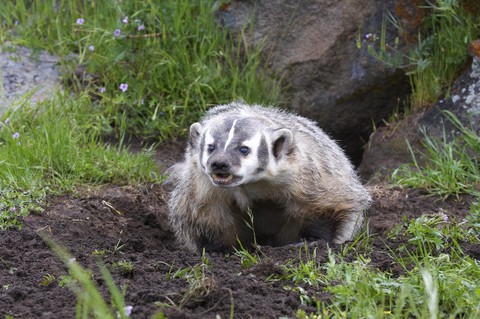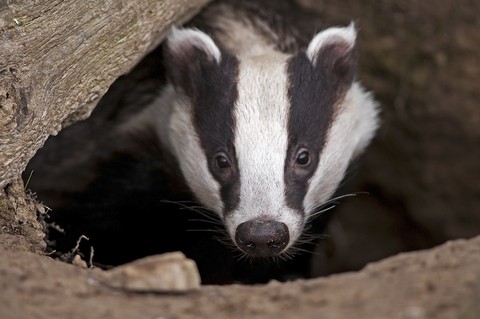American Badgers are members of the Mustelidae family of carnivorous small mammals. This means they’re related to wolverines, fishers, martens, mink, weasels, and other similar animals. After the wolverine, they’re the second-largest terrestrial mustelid. In the mustelid family, there are three types of otters that are larger than both wolverines and badgers, but otters are semi-aquatic.
American Badger Description
American Badgers share similar characteristics with other mustelids such as fishers and wolverines. They are the stockiest of the mustelids, though. These animals have a proportionately broad and flat body with short, stout legs.
These animals are burrowers. They have long curved claws on their front feet that aid them in clawing through the ground. Their back feet and claws are adapted for throwing the dirt behind them as they go.
American Badger Size
American badgers are anywhere from 18 to 22 inches long, from the tip of their nose to the base of their tails. Their bushy tails are 4 to 6 inches long. Adults of the species range in weight from 13 to 25 pounds. Males are larger than females.
Coloration
In coloration, these animals are a grizzled grey, tan and white. They have a white stripe that begins at the base of their neck and extends up the center of their neck and head and down the center of their face, ending in the middle of their black nose. In the southwestern subspecies, this white stripe extends from the middle of their nose to the base of their tail. Source Additionally, they have cream-colored stripes that come down around the outside of each eye and meet under the chin. These cream-colored stripes are sided by black sideburns that extend from the top of their head and down their face before also ending under their chin.
American Badger Behavior
They are solitary animals and are most active with their hunting after dark. However, in areas where they are not heavily pressured by the presence of humans, you’ll find them out hunting during the daylight hours.
People often ask the question, “Are badgers mean?“. The answer to that is that if you put them in a corner, they will defend themselves very aggressively. Badgers are related to wolverines, and they act similarly to them. They will bear their teeth, snarl, and make bluff charges at their tormenter. Any predator that doesn’t move out of the way fast enough will have to deal with the badger’s sharp teeth and claws. Additionally, when you really get them annoyed, they discharge a smelly spray from their anal glands just like all other mustelids do.
What do American Badgers Eat?
They primarily eat rodents such as voles, mice, rats, prairie dogs, and ground squirrels. These animals are very good at burrowing. Consequently, they dig these rodents right up from their burrows. Additionally, they’ll prey on rabbits, ground-nesting birds, snakes “including rattlesnakes,” earthworms,” insects, and carrion. This also depends on the available prey in the area they’re living in.
On an interesting side note, American badgers are somewhat immune to rattlesnake venom. In some areas, they are a major rattlesnake predator.
American Badger Predators
Bears, wolves, bobcats, and mountain lions all prey on American badgers. Golden eagles will also prey on their young. Coyotes have an interesting relationship with badgers. They prey on them sometimes. On the other hand, sometimes coyotes and badgers team up to hunt together. See, Last on the list are humans. Humans trap badgers for their fur. People use badger hair to make shaving and oil painting brushes.
American Badger Habitat
These animals primarily live on the prairie grasslands of North America. They also live in the high desert country of the western United States. and right up to the foothills and the Mountains. To a lesser extent, they also inhabit open mountain meadows and forest glades, and swampy areas.
American Badger Range
You may be asking the question, “Where do American badgers live?” They inhabit a large portion of North America. The northern boundary of their range begins in southern Canada. British Columbia, Alberta, Saskatchewan, Manitoba, and Ontario all have American badgers. The southern boundary of their range is in northern Mexico.
In the United States, their range begins on the west coast and stretches to the east coast in certain states. They also range from the Canadian border in the north to Texas in the south. People sometimes ask, “What states do badgers live in?“. The following is an alphabetical list of the American states with American badger populations.
- Alabama
- Arizona
- Arkansas
- California
- Colorado
- Idaho
- Illinois
- Indiana
- Iowa
- Kansas
- Kentucky
- Louisiana
- Maine
- Michigan
- Minnesota
- Mississippi
- Missouri
- Montana
- Nebraska
- Nevada
- New Hampshire
- New Mexico
- New York
- North Dakota
- Ohio
- Oklahoma
- Oregon
- Pennsylvania
- South Dakota
- Texas
- Utah
- Washington
- Wisconsin
- Wyoming
American Badger vs. European Badger
The American badger and the European badger are both mustelids. They have visual similarities to one another, although they are not that closely related. American badgers stem from the subfamily, Melinae, while European badgers stem from the subfamily, Taxideinae.


American Badger
- Family: Mustelidae
- Subfamily: Melinae
- Coloration: Grizzled black, grey, tan, and white with a black and white striped face.
- Diet: Carnivore. Their diet includes voles, mice, rats, prairie dogs, ground squirrels, rabbits, ground-nesting birds, snakes “including rattlesnakes,” earthworms,” insects, and carrion.
- Size: 18 to 22 inches ( 46 to 56cm) long, from the tip of their nose to the base of their tails. Their bushy tails are 4 to 6 inches (10 to 15 cm) long. Adults of the species range in weight from 13 to 25 pounds (6 to 11kg) Source
- Range: The United States, Southern Canada, and Northern Mexico.
European Badger
- Family: Mustelidae
- Subfamily: Taxideinae
- Coloration: Grizzled black, grey, tan, and white with a black and white striped face.
- Diet: Omnivore. Their diet includes earthworms, insects, shrews, moles, mice, rabbits, hedgehogs, snakes, grass, seeds, and fruit.
- Size: Shoulder height 25 to 30 cm (9.8 to 11.8 in), Body length 60 to 90 cm (24 to 35 in) Tail length 12 to 24 cm (4.7 to 9.4 in) 7.5 to 13 cm (3.0 to 5.1 in) Their weights fluctuate with the season. During the summer, European badgers commonly weigh 7 to13 kg (15 to 29 lb) and 15 to 17 kg (33 to 37 lb) in autumn. Source
- Range: Continental Europe and the United Kingdom.
Recent Posts
The only venomous snakes in Washington State are Northern Pacific Rattlesnakes. The Northern Pacific Rattlesnake (Crotalus oreganus oreganus) is a sub-species of the Western Rattlesnake. Anyone...
Skunks are not classified as true hibernators. But they go into a state of torpor when the weather gets cold. Skunks are light sleep hibernators, along with opossums, bears, and raccoons. ...

